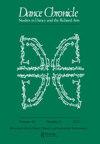Interdisciplinary Rewards and Challenges
IF 0.1
3区 艺术学
0 DANCE
引用次数: 0
Abstract
The editors of Musicology and Dance: Historical and Critical Perspectives desire to encourage a “dance-attentive musicology” that explores “how physical expression might inform musical expression—as well as how music might inscribe new meanings onto the moving body” (pp. 8–9). This volume of ten wide-ranging essays is divided into three parts: “Conceptual Studies,” “Case Histories,” and “Critical Readings.” Within each part, the essays offer contrast with respect to subject matter, critical methodology, and perspective; in so doing, they demonstrate the potential for growth within this neglected area of interdisciplinary engagement. Part 1 opens with “J. S. Bach and the Dance of Humankind,” in which Bach scholar and conductor John Butt reveals how the composer’s music embodies the physicality of dances from the period, not only in pieces with dance titles, but also, to give just two of his examples, in the saraband-based final choruses of the St. John and St. Matthew Passions and the third, gigue-like movement of the fourth Brandenburg Concerto. He writes that “most commentators tend to gravitate towards the notion of music as disembodied thought when contemplating Bach’s achievements” but that “we also share a sense of physicality with our ancestors that is arguably just as important, if not more so, than the mental process” (p. 21). Butt cautions, however, that perception of these relationships in Bach “presupposes that the physical allusions and memories are somehow felt in the body of the listener rather than merely intellectualized” and that “such an experiential framework . . . may or may not complement the range of experiences the listener draws from [the music]” (p. 46). The next chapter—and the only one not to focus on a particular composer, choreographer, dancer, musical work, dance type, or genre—is Suzanne Aspden’s “Dance as ‘Other’: Contrasting Modes of Musical Representation.” In her introductory paragraph, Aspden quotes anthropologist Ruth Finnegan’s observation that “popular and ‘other’ music, in the跨学科的奖励和挑战
《音乐学与舞蹈:历史与批判视角》的编辑们希望鼓励“关注舞蹈的音乐学”,探索“身体表达如何影响音乐表达,以及音乐如何在运动的身体上赋予新的意义”(第8-9页)。这本由十篇内容广泛的文章组成的卷分为三部分:“概念研究”、“案例史”和“批判性阅读”。在每一部分中,文章都在主题、批判性方法论和视角方面进行了对比;通过这样做,他们展示了在这个被忽视的跨学科参与领域内发展的潜力。第一部分以“J.S.巴赫与人类之舞”开场,巴赫学者兼指挥家约翰·巴特在其中揭示了这位作曲家的音乐是如何体现这一时期舞蹈的物理性的,不仅是在有舞蹈标题的作品中,而且,举两个例子,在以萨拉班德为基础的圣约翰和圣马修激情的最后合唱中,勃兰登堡第四协奏曲中的类似音乐会的乐章。他写道,“大多数评论家在思考巴赫的成就时,往往倾向于将音乐视为无实体的思想”,但“我们也与祖先有着共同的物质感,这可以说与心理过程同样重要,甚至更重要”(第21页)。然而,巴特警告说,巴赫对这些关系的感知“预设了身体暗示和记忆在听众的身体中以某种方式感受到,而不仅仅是智能化的”,“这样的经验框架……可能会也可能不会补充听众从[音乐]中获得的经验范围”(第46页)。下一章是苏珊娜·阿斯普登(Suzanne Aspden)的《作为‘其他’的舞蹈:音乐表现的对比模式》(dance as‘Other’:Contrasting Modes of musical Representation),也是唯一一章不关注特定作曲家、编舞家、舞者、音乐作品、舞蹈类型或流派的章节
本文章由计算机程序翻译,如有差异,请以英文原文为准。
求助全文
约1分钟内获得全文
求助全文
来源期刊

DANCE CHRONICLE
DANCE-
CiteScore
0.40
自引率
0.00%
发文量
22
期刊介绍:
For dance scholars, professors, practitioners, and aficionados, Dance Chronicle is indispensable for keeping up with the rapidly changing field of dance studies. Dance Chronicle publishes research on a wide variety of Western and non-Western forms, including classical, avant-garde, and popular genres, often in connection with the related arts: music, literature, visual arts, theatre, and film. Our purview encompasses research rooted in humanities-based paradigms: historical, theoretical, aesthetic, ethnographic, and multi-modal inquiries into dance as art and/or cultural practice. Offering the best from both established and emerging dance scholars, Dance Chronicle is an ideal resource for those who love dance, past and present. Recently, Dance Chronicle has featured special issues on visual arts and dance, literature and dance, music and dance, dance criticism, preserving dance as a living legacy, dancing identity in diaspora, choreographers at the cutting edge, Martha Graham, women choreographers in ballet, and ballet in a global world.
 求助内容:
求助内容: 应助结果提醒方式:
应助结果提醒方式:


